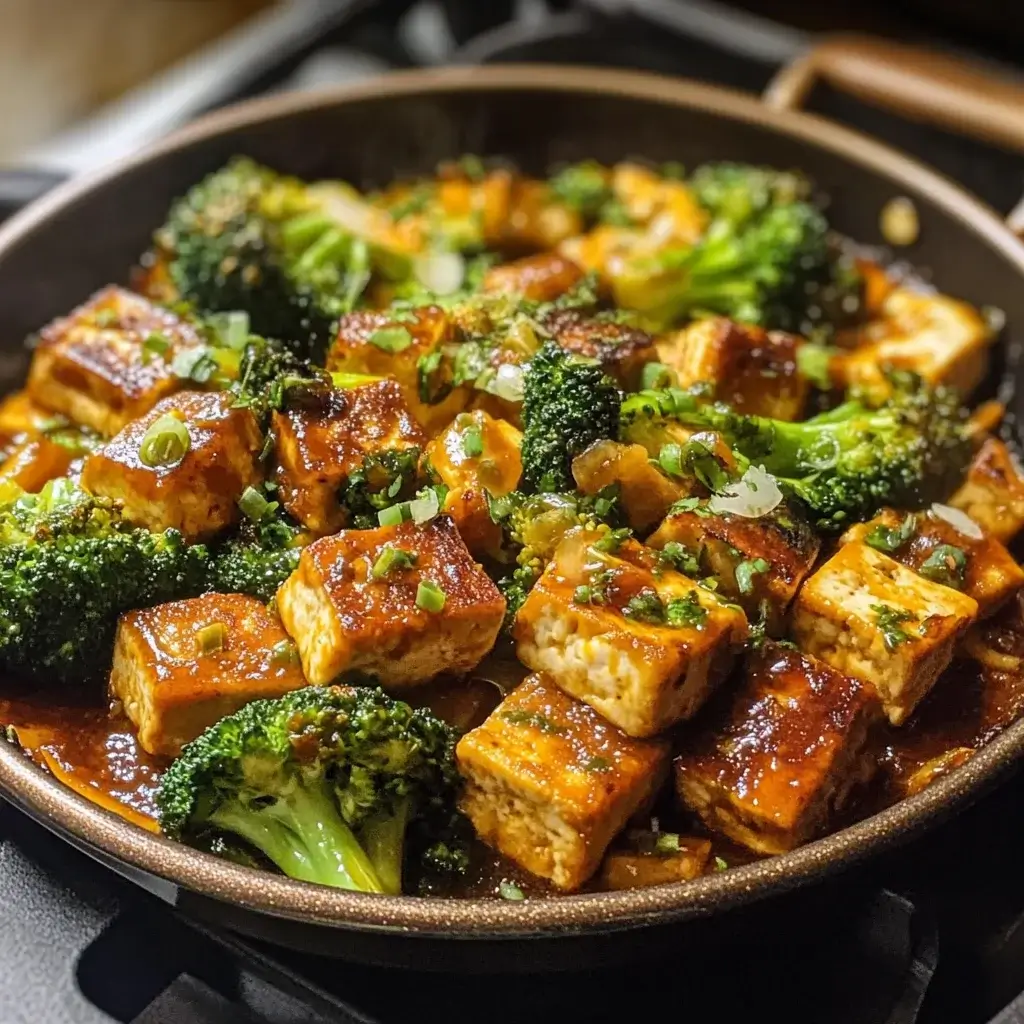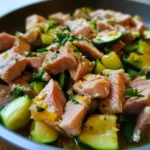I have to confess, my household used to be a tough crowd when it came to tofu. The words “spongy” and “bland” were thrown around more often than I’d like to admit. I was on a mission to find a tofu recipe that would not only win me over but convert the skeptics in my family. Enter this One-Pan Tofu and Broccoli. The first time I made it, the aroma wafting from the oven was already promising. The tofu, baked to a delightful crispiness on the outside and still tender within, paired with perfectly roasted broccoli, all coated in a savory, slightly sweet, and umami-rich sauce… it was a revelation! My partner, usually the first to eye tofu with suspicion, actually asked for seconds. My kids, who often push broccoli around their plates, devoured it. It’s since become an absolute staple in our weekly meal rotation. Not only is it ridiculously delicious and satisfying, but the sheer simplicity of tossing everything onto one pan and letting the oven do the work is a game-changer for busy weeknights. Clean-up is a breeze, and it feels like a wholesome, nourishing meal that everyone genuinely enjoys. This recipe isn’t just food; it’s a little slice of weeknight sanity and a testament to how amazing plant-based eating can be when done right.
Ingredients
- 1 (14-16 ounce) block extra-firm or firm tofu: Pressed very well and cut into 1-inch cubes. Using extra-firm and pressing it is key to achieving a crispy texture.
- 1 large head of broccoli (about 1 pound): Cut into medium-sized florets. Ensure they are relatively uniform in size for even cooking.
- 2 tablespoons olive oil or avocado oil: A neutral-flavored oil with a high smoke point is ideal for roasting.
- 3 tablespoons low-sodium soy sauce or tamari: The primary source of salty and umami flavor. Use tamari for a gluten-free option.
- 2 tablespoons rice vinegar: Adds a pleasant tanginess that balances the other flavors.
- 1 tablespoon maple syrup or agave nectar: Provides a touch of sweetness to round out the sauce; adjust to your preference.
- 1 tablespoon toasted sesame oil: Imparts a distinct, nutty aroma and flavor. A little goes a long way.
- 2 cloves garlic, minced: Fresh garlic provides the best flavor, but garlic powder can be substituted in a pinch (use about 1/2 teaspoon).
- 1 teaspoon fresh ginger, grated or finely minced: Adds a warm, zesty kick. Ginger powder can be used (about 1/4 teaspoon), but fresh is superior.
- 1 tablespoon cornstarch (or arrowroot starch): Helps to thicken the sauce slightly and aids in crisping the tofu.
- Optional Garnish: Sesame seeds, sliced green onions: For a pop of color, texture, and fresh flavor upon serving.
- Optional for spice: 1/2 teaspoon sriracha or a pinch of red pepper flakes: If you enjoy a bit of heat, add this to the sauce.
Instructions
- Prepare the Tofu: If you haven’t already, press the tofu. Wrap the block of tofu in several layers of paper towels or a clean kitchen towel. Place something heavy on top (like a few cookbooks or a cast-iron skillet) and let it press for at least 30 minutes, or up to an hour, changing the towels if they become saturated. This step is crucial for removing excess water, which allows the tofu to get crispy. Once pressed, cut the tofu into 1-inch cubes.
- Preheat Oven and Prepare Pan: Preheat your oven to 400°F (200°C). Line a large baking sheet with parchment paper for easy cleanup. This also helps prevent sticking.
- Whisk the Sauce: In a small bowl, whisk together the soy sauce (or tamari), rice vinegar, maple syrup (or agave), toasted sesame oil, minced garlic, grated ginger, and cornstarch (and sriracha/red pepper flakes, if using). Whisk until the cornstarch is fully dissolved and there are no lumps. This sauce is the heart of the dish, providing a beautiful glaze and immense flavor.
- Coat the Tofu: Place the cubed tofu in a medium-sized bowl. Pour about two-thirds of the prepared sauce over the tofu. Gently toss to ensure each piece is well-coated. Let it marinate for at least 10-15 minutes while you prepare the broccoli, or longer if you have time (up to 30 minutes at room temperature, or cover and refrigerate for several hours for deeper flavor). The cornstarch in the marinade will help create that desirable crispy exterior during baking.
- Prepare the Broccoli: While the tofu marinates, place the broccoli florets in a separate large bowl. Drizzle with the olive oil (or avocado oil) and toss to coat evenly. You can add a pinch of salt and pepper here if desired, but remember the sauce for the tofu is quite flavorful.
- Arrange on Baking Sheet: Spread the marinated tofu in a single layer on one side of the prepared baking sheet. Spread the oil-coated broccoli florets in a single layer on the other side. It’s important not to overcrowd the pan; if necessary, use two baking sheets. Overcrowding will cause the ingredients to steam rather than roast, preventing them from getting crispy and developing those lovely caramelized edges.
- Roast: Place the baking sheet in the preheated oven. Roast for 20-25 minutes, flipping the tofu cubes and stirring the broccoli halfway through, around the 10-12 minute mark. This ensures even cooking and browning on all sides.
- Final Glaze and Finish: After 20-25 minutes, check the tofu and broccoli. The tofu should be golden brown and slightly crispy, and the broccoli should be tender-crisp and slightly charred at the edges. Drizzle the remaining one-third of the sauce over both the tofu and broccoli. Toss gently right on the pan to coat everything.
- Return to Oven (Optional but Recommended): Return the pan to the oven for another 3-5 minutes. This allows the fresh layer of sauce to heat through, caramelize slightly, and thicken, giving the dish a wonderful final glaze. Keep a close eye on it to prevent burning, especially due to the sugars in the maple syrup.
- Serve: Remove from the oven. Let it cool for a minute or two. Serve immediately, garnished with sesame seeds and sliced green onions, if desired.
Nutrition Facts
- Servings: Approximately 2-3 servings
- Calories per serving: Roughly 350-450 calories (this can vary based on exact ingredient amounts, oil used, and if served with grains)
- Protein: Approximately 20-25g per serving. Tofu is an excellent source of complete plant-based protein, essential for muscle repair, immune function, and satiety.
- Fiber: Approximately 6-8g per serving. Broccoli is packed with dietary fiber, which aids digestion, helps regulate blood sugar, and promotes a feeling of fullness.
- Vitamin C: High. Broccoli is a fantastic source of Vitamin C, a powerful antioxidant that supports the immune system and collagen production.
- Iron: Good source. Both tofu and broccoli contribute to iron intake, which is vital for oxygen transport in the blood and preventing fatigue.
- Healthy Fats: Moderate. Primarily from the olive/avocado oil and sesame oil, providing monounsaturated and polyunsaturated fats which are beneficial for heart health.
Preparation Time
- Total Active Preparation Time: Approximately 20-25 minutes. This includes pressing the tofu (can be done passively), chopping the broccoli, whisking the sauce, and arranging ingredients on the pan.
- Tofu Pressing Time (Passive): 30 minutes to 1 hour. While this adds to the overall timeline, it requires minimal active effort. You can do other things while the tofu presses.
- Marinating Time (Passive/Optional): 10-30 minutes (or longer if refrigerated).
- Cooking Time: Approximately 25-30 minutes.
- Overall Time (including passive pressing/marinating): Roughly 1 hour 15 minutes to 2 hours, but the hands-on time is significantly less, making it manageable for a weeknight. The actual “work” part is quick and efficient.
How to Serve
This One-Pan Tofu and Broccoli is wonderfully versatile and can be served in numerous ways to create a complete and satisfying meal:
- Over Grains:
- Brown Rice: The nutty flavor and chewy texture of brown rice complement the dish beautifully and add extra fiber.
- Quinoa: A protein-packed, gluten-free grain that makes the meal even more nutritious.
- White Jasmine or Basmati Rice: Fluffy and fragrant, these rices are a classic pairing for Asian-inspired flavors.
- Cauliflower Rice: For a low-carb, grain-free option, serve over steamed or sautéed cauliflower rice.
- With Noodles:
- Soba Noodles: Earthy buckwheat noodles are a fantastic match.
- Udon Noodles: Thick, chewy udon noodles would make this a hearty bowl.
- Rice Noodles: Thin vermicelli or thicker pad thai style noodles would work well. Toss the cooked noodles with a little extra soy sauce or sesame oil before topping with the tofu and broccoli.
- As a Bowl Component:
- Create a “Buddha Bowl” or “Nourish Bowl” by arranging the tofu and broccoli alongside other components like:
- Sliced avocado for creamy healthy fats.
- Shredded carrots or pickled radishes for crunch and color.
- Edamame (shelled) for extra plant-based protein.
- A drizzle of extra sriracha or a peanut sauce.
- Create a “Buddha Bowl” or “Nourish Bowl” by arranging the tofu and broccoli alongside other components like:
- In Lettuce Wraps:
- For a lighter, low-carb meal, serve the tofu and broccoli in crisp lettuce cups (like butter lettuce or romaine).
- Alongside a Simple Salad:
- Pair with a light Asian-inspired slaw made with shredded cabbage, carrots, and a sesame-ginger vinaigrette.
- With Extra Toppings:
- Chopped Peanuts or Cashews: For added crunch and nutty flavor.
- Fresh Cilantro Leaves: If you’re a cilantro fan, it adds a lovely fresh note.
- A Squeeze of Lime Juice: Brightens all the flavors just before serving.
- Furikake: A Japanese seaweed seasoning that adds umami and visual appeal.
- Meal Prep:
- Portion the cooked tofu and broccoli into individual containers with your chosen grain or base. It reheats well, making it perfect for lunches throughout the week.
Additional Tips
- Master the Tofu Press: Don’t skimp on pressing the tofu. The more water you remove, the firmer and crispier your tofu will become. If you make tofu often, consider investing in a dedicated tofu press – they are quite efficient. If not, the towel-and-heavy-object method works perfectly well, just ensure you apply even pressure.
- Don’t Overcrowd the Pan: This is a golden rule for roasting anything. Giving the tofu and broccoli space allows hot air to circulate around each piece, promoting browning and crisping. If your ingredients are too close together, they will steam, resulting in softer, less flavorful results. Use two sheet pans if necessary; it’s worth the extra dish to wash.
- Uniform Sizing is Key: Cut your tofu into evenly sized cubes and your broccoli florets into relatively uniform pieces. This ensures everything cooks at the same rate. If some pieces are much larger than others, the smaller ones might burn before the larger ones are cooked through.
- High Heat for Crispiness: Roasting at 400°F (200°C) is crucial for achieving that desirable crispy exterior on the tofu and nicely charred edges on the broccoli. Don’t be tempted to lower the heat unless your oven runs particularly hot and you notice things browning too quickly.
- Marinade Magic: While 10-15 minutes of marinating time for the tofu works for a quick meal, if you have more time, let it marinate for longer (up to a few hours or even overnight in the refrigerator). This allows the flavors to penetrate deeper into the tofu. Always bring refrigerated marinated tofu to room temperature for about 20-30 minutes before baking for more even cooking.
- Vary Your Veggies: While broccoli is classic, feel free to substitute or add other sturdy vegetables that roast well. Bell peppers (any color, sliced), red onion (cut into wedges), zucchini (cut into thick half-moons), snap peas, or green beans would all be delicious additions. Adjust roasting time as needed based on the density of the vegetables. Softer vegetables like zucchini might need to be added partway through cooking.
- Taste and Adjust Sauce: Before using, taste your sauce. Does it need more sweetness? A bit more tang from the vinegar? A bigger kick of ginger? Everyone’s palate is different, so feel free to make small adjustments to the sauce ingredients to suit your preference. Remember that the flavor will concentrate slightly as it cooks.
- Storage and Reheating: Store leftovers in an airtight container in the refrigerator for up to 3-4 days. To reheat, you can microwave it, but for best results (to revive some crispiness), reheat on a baking sheet in a 350°F (175°C) oven or in an air fryer for 5-10 minutes until warmed through.
FAQ Section
Q1: Can I use frozen broccoli for this recipe?
A1: Yes, you can use frozen broccoli, but it may not get as crispy as fresh broccoli due to its higher water content. Thaw the frozen broccoli completely and pat it very dry with paper towels before tossing it with oil and roasting. You might also need to add a few extra minutes to the roasting time. It will still be delicious, just with a slightly softer texture.
Q2: My tofu never gets crispy. What am I doing wrong?
A2: There are a few common culprits for soggy tofu. Firstly, ensure you’re using firm or extra-firm tofu; silken or soft tofu won’t work for this type of recipe. Secondly, pressing the tofu thoroughly is non-negotiable. Removing excess water is key. Thirdly, the cornstarch in the marinade is a secret weapon for crispiness. Fourthly, don’t overcrowd the pan – give the tofu pieces space to roast, not steam. Finally, ensure your oven is hot enough (400°F/200°C). Using an air fryer for the tofu portion can also yield exceptionally crispy results.
Q3: Is this recipe gluten-free?
A3: This recipe can easily be made gluten-free. The main ingredient to watch out for is soy sauce. To make it gluten-free, simply substitute the regular soy sauce with tamari or a certified gluten-free soy sauce. All other typical ingredients (tofu, broccoli, rice vinegar, maple syrup, sesame oil, garlic, ginger, cornstarch) are naturally gluten-free, but always double-check labels if you have celiac disease or severe gluten sensitivity, especially for cornstarch to ensure no cross-contamination.
Q4: What are some good substitutes for soy sauce if I have a soy allergy or want to avoid it?
A4: If you have a soy allergy, you’ll need to avoid tofu as well. However, if you’re just looking to replace soy sauce (perhaps for a different recipe or a mild intolerance), coconut aminos are a popular soy-free and gluten-free alternative. They are slightly sweeter than soy sauce, so you might want to reduce the maple syrup slightly. Liquid aminos (like Bragg’s) are another option, but they are often soy-based, so check the label. For a completely different flavor profile but still umami-rich, a mushroom-based broth or a homemade umami sauce could be experimented with, though it would significantly change the dish’s character.
Q5: Can I prepare any parts of this recipe in advance?
A5: Absolutely! To save time on a busy night:
* Press Tofu: Press the tofu a day ahead and store it wrapped in the refrigerator.
* Chop Broccoli: Cut the broccoli florets and store them in an airtight container in the fridge for up to 2-3 days.
* Make the Sauce: Whisk together the sauce ingredients (except perhaps the cornstarch, which can be whisked in just before use if making far ahead) and store it in an airtight container in the refrigerator for up to 3-4 days.
* Marinate Tofu: You can cube the pressed tofu and let it marinate in the sauce in the refrigerator for several hours or even overnight.
With these components prepped, the actual assembly and baking will be very quick.
Q6: What other proteins could I use with this sauce and roasting method?
A6: While this recipe is centered on tofu, the sauce and roasting method are quite versatile. You could try:
* Tempeh: Crumbled or cubed tempeh would work well and offers a nuttier, chewier texture.
* Chickpeas: Canned chickpeas (rinsed and dried) tossed in the sauce and roasted until slightly crispy.
* Chicken or Shrimp (for non-vegans): Cubed chicken breast or peeled shrimp could be marinated and roasted similarly, adjusting cooking times as needed (shrimp will cook much faster).
The key is to choose a protein that benefits from roasting and pairs well with the savory-sweet Asian-inspired flavors.
Q7: My sauce didn’t thicken much. What happened?
A7: There are a couple of reasons your sauce might not have thickened as expected.
* Cornstarch Amount: Ensure you used the correct amount of cornstarch. If your sauce is still too thin, you can make a small slurry (1 teaspoon cornstarch mixed with 1 tablespoon cold water) and whisk it into the remaining sauce when you do the final glaze, then return to the oven for a few minutes.
* Not Enough Heat/Time for Final Glaze: The final 3-5 minutes in the oven after adding the reserved sauce is when much of the thickening and caramelization happens. If you skipped this or didn’t leave it in long enough, the sauce might remain thinner.
* Too Much Liquid Overall: If your broccoli released a lot of water, or if your tofu wasn’t pressed well, it could dilute the sauce.
Q8: How can I adjust the spice level of this dish?
A8: This recipe is quite mild by default. To increase the spice:
* Sriracha or Gochujang: Add more sriracha or a teaspoon of gochujang (Korean chili paste) to the sauce. Start with a little and add more to taste.
* Red Pepper Flakes: Increase the amount of red pepper flakes in the sauce, or sprinkle extra on top before serving.
* Fresh Chili: Finely mince a fresh chili (like a bird’s eye or jalapeño, seeds removed for less heat) and add it to the sauce.
* Chili Garlic Sauce: A dollop of chili garlic sauce can be whisked into the marinade.
Conversely, if you want absolutely no hint of spice, simply omit the optional sriracha or red pepper flakes.






